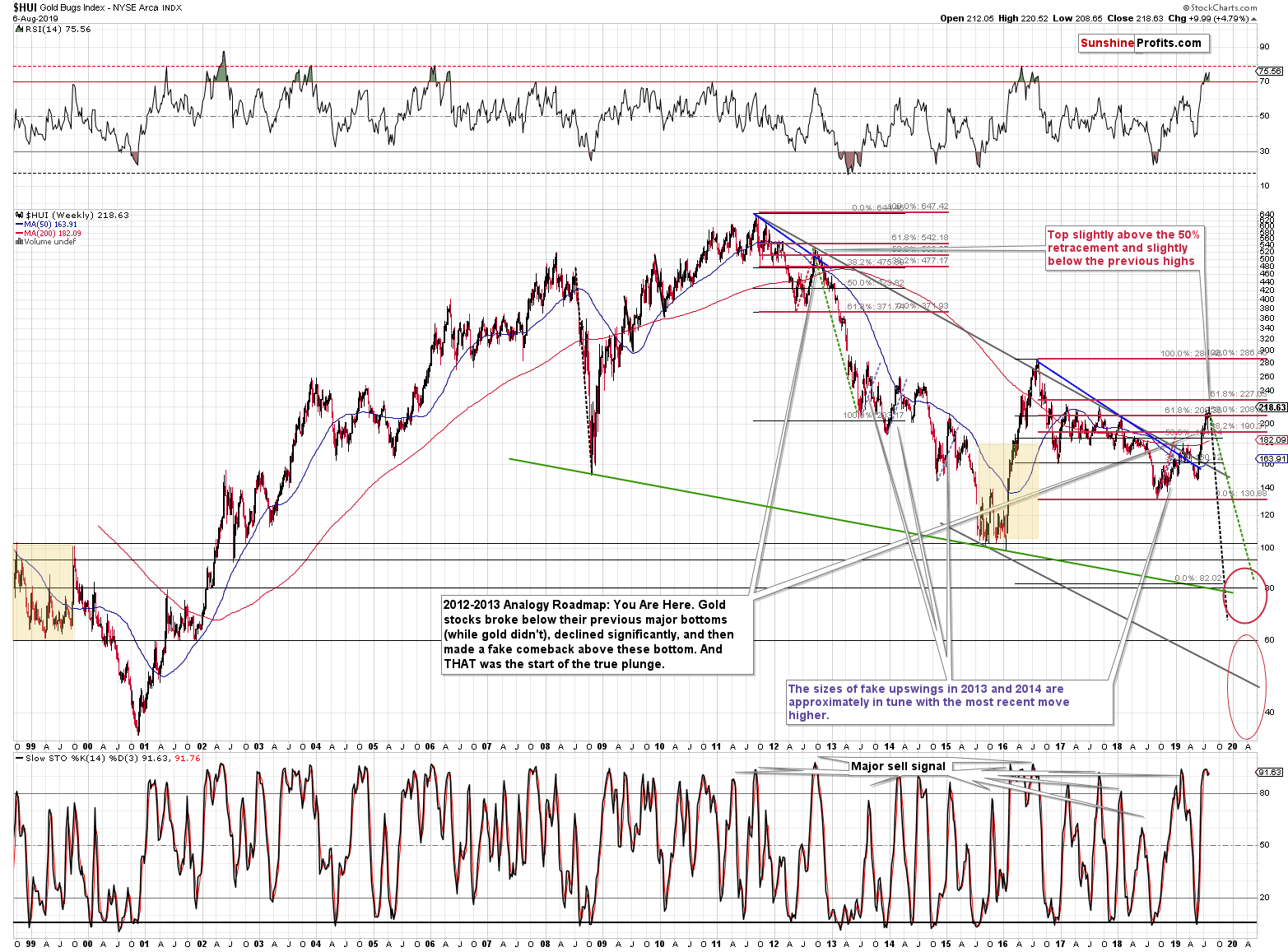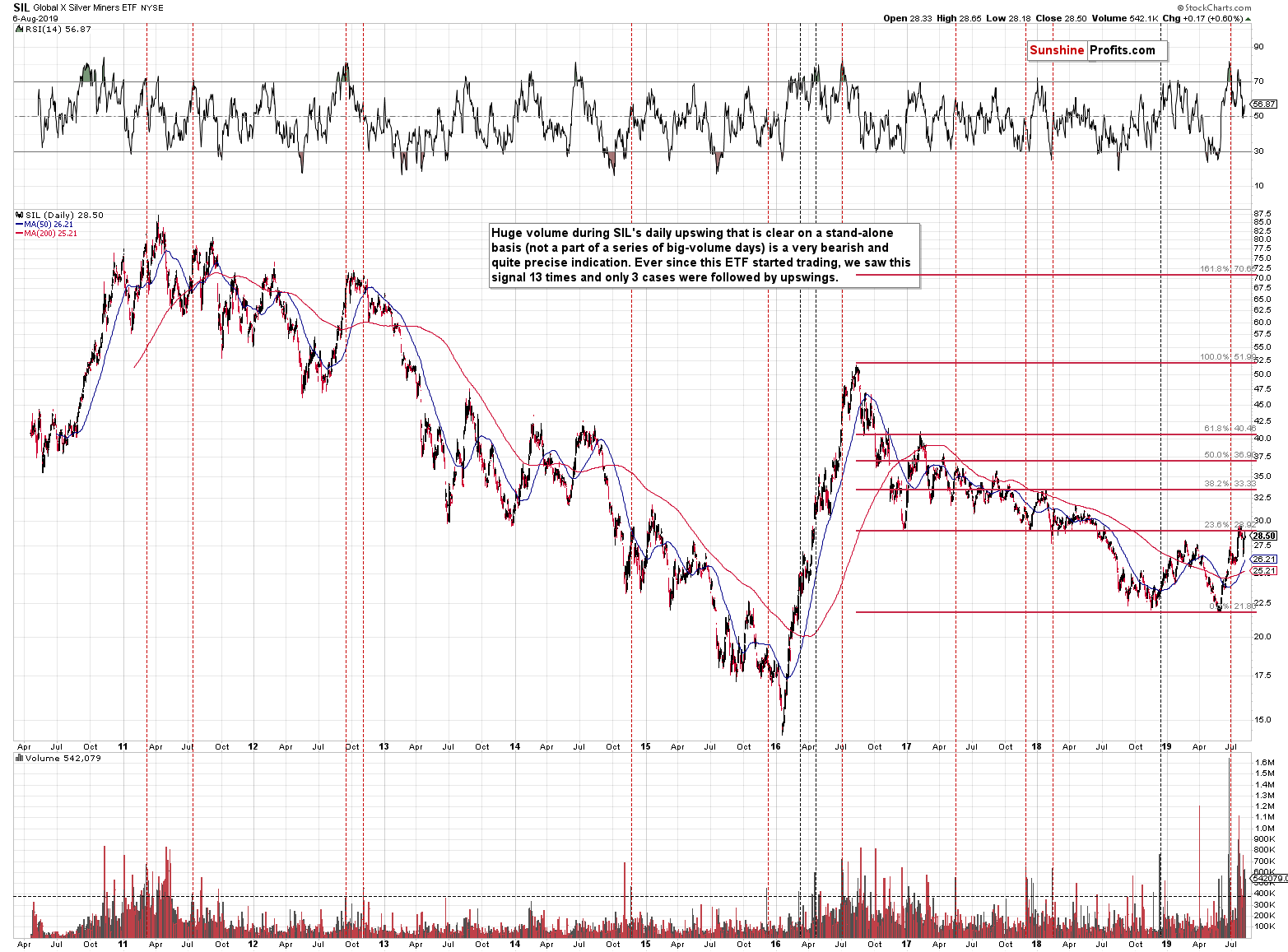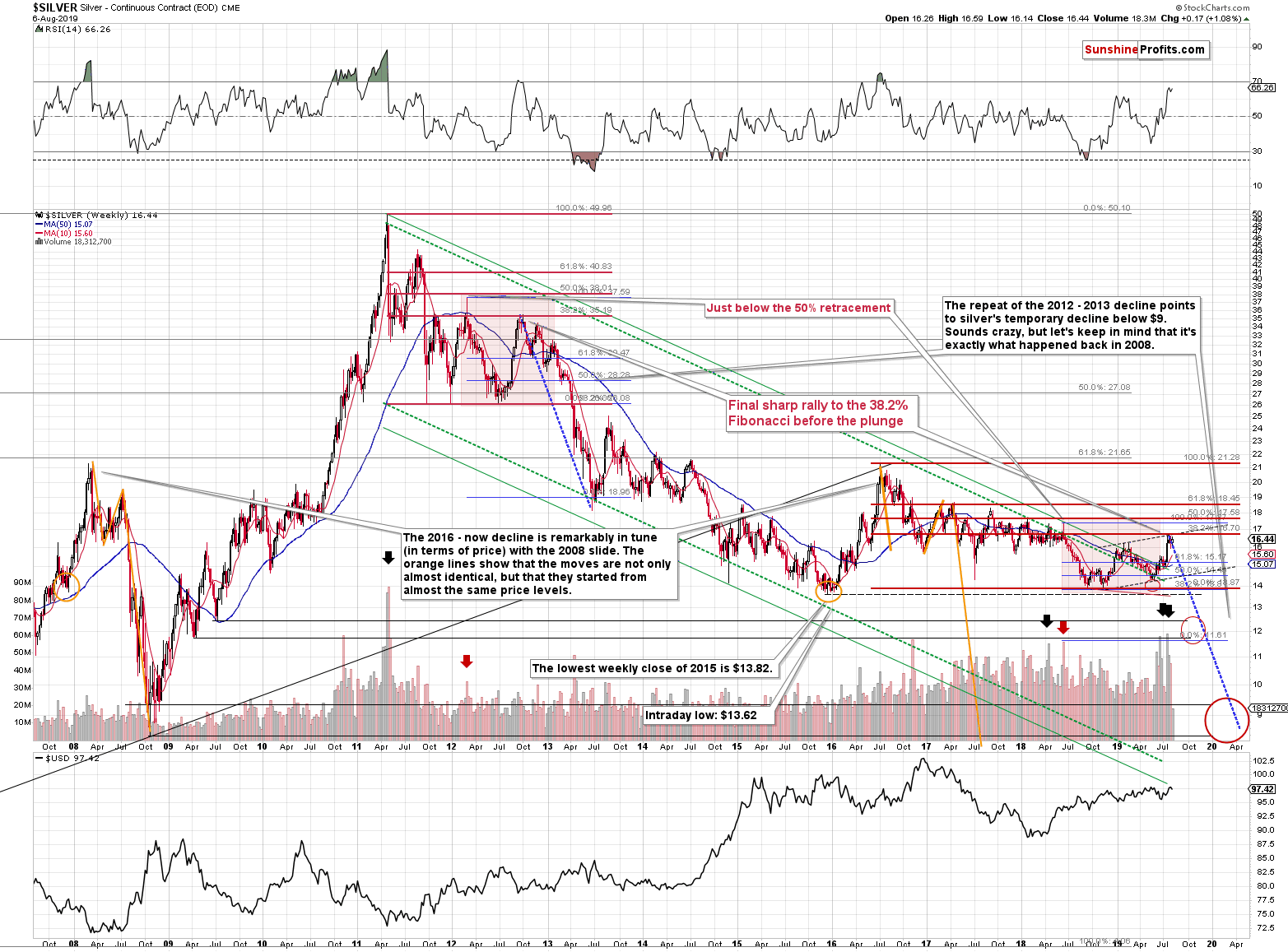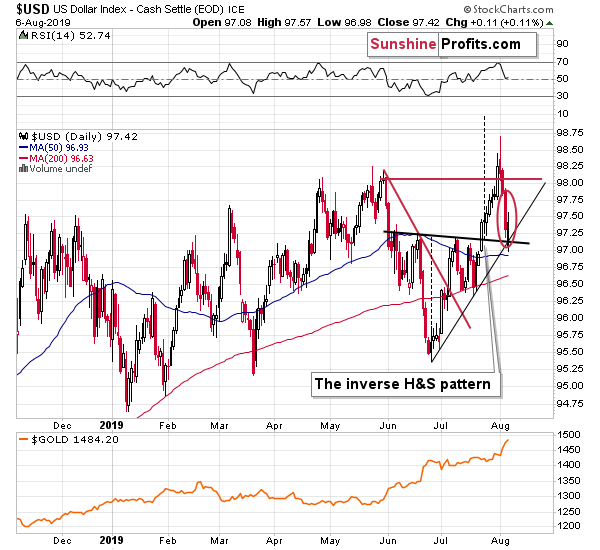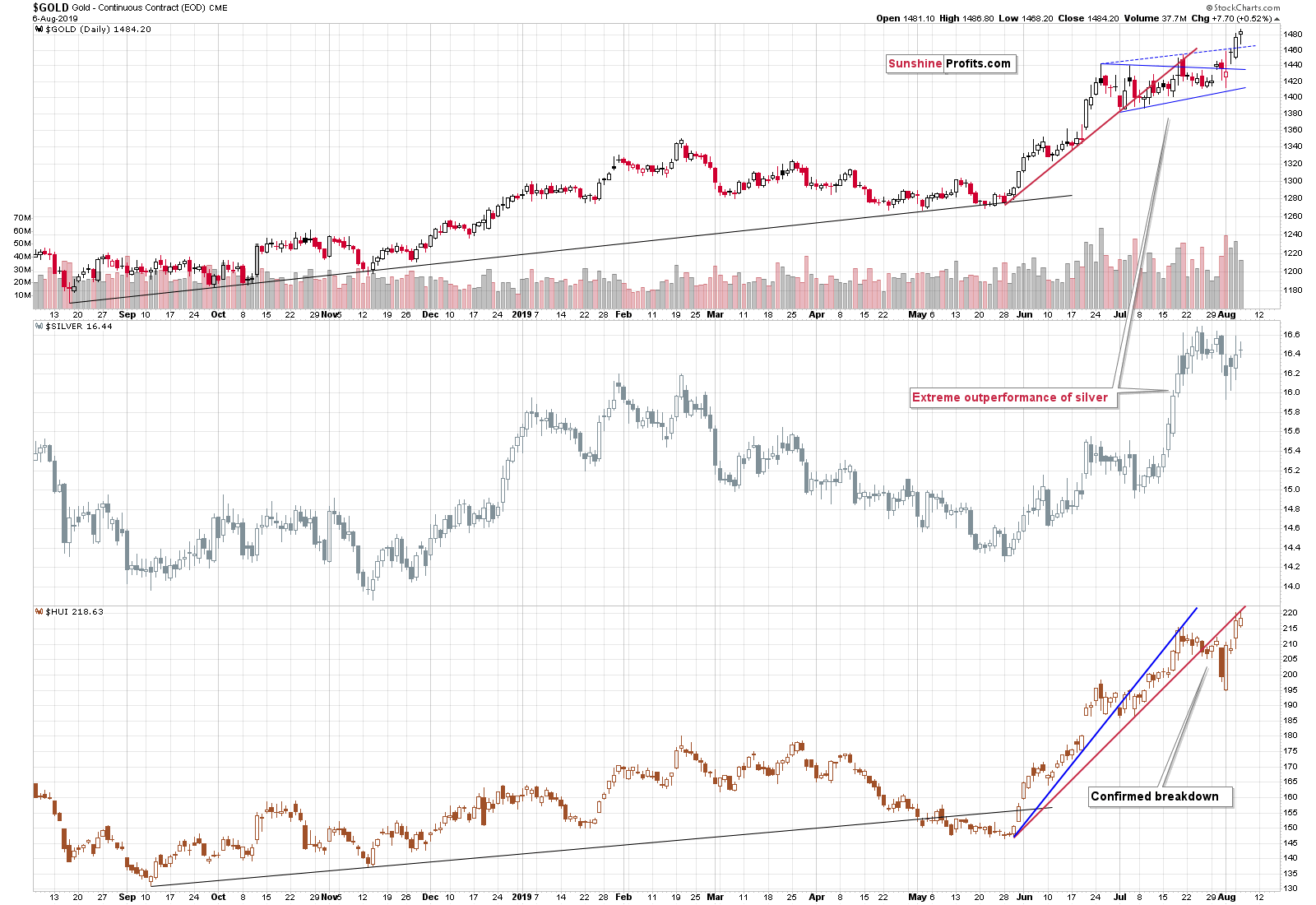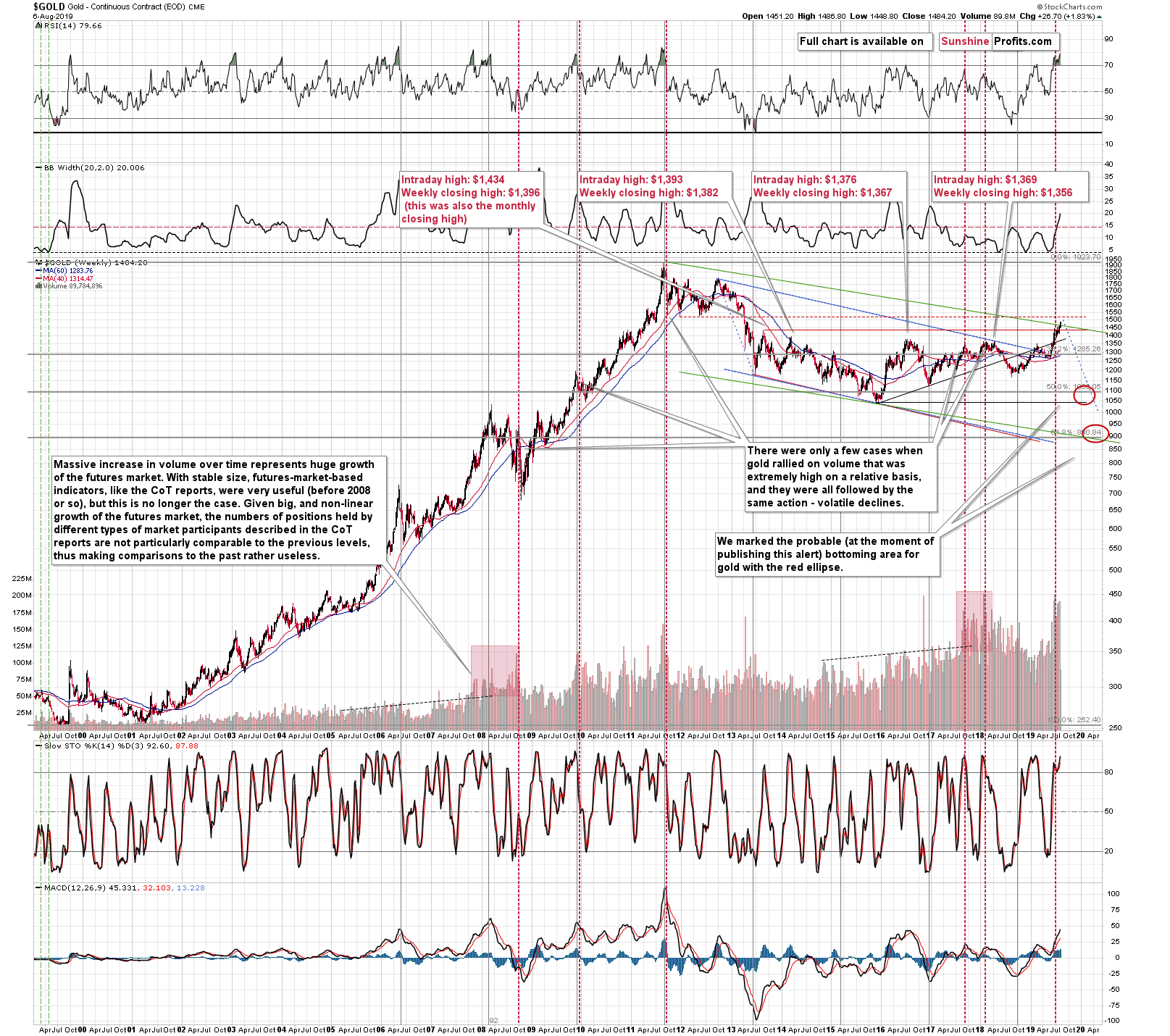Briefly: in our opinion, at the moment of publishing this Alert no speculative short positions are justified, but we are placing orders to re-enter full (250% of the regular size of the position) speculative short position in gold, silver, and mining stocks once gold reaches $1,519 (regardless of where silver and mining stocks are trading at that time)
Gold futures just soared above $1,500 (and then back below it) most likely due to investors' worries about the trade and currency war with China. As we had expected, the reaction to new trade threats took several days to unfold. Silver finally moved higher as well, but overall - taking the last few days into account - the extent of the move has not been as significant as the one in gold. What's next? Can gold keep the momentum and rally much higher?
That's unlikely. First of all, the entire rally is most likely based on geopolitical factors and moves of this kind are usually reversed.
Second, this is especially the case with moves that are based on geopolitical threats or developments that are likely to be reversed. That's the case with the current trade war threats. Remember the threats regarding North Korea? Nothing happened and practically everything regarding the crisis was reversed. Remember the promise that was one of the foundations of the presidential campaign? Well, where's the wall? There was a lot of smoke and mirrors to get the desired result (winning the elections), but little to no real action. The same is likely the case with the China trade war. Gold gains as both sides of the conflict flex their muscles, but with no real action behind it, everything can easily be reversed. And it's likely to, as no side really wants to suffer the consequences of the full-blown trade war.
Also, have you noticed that the UK still remains in the EU? Different political articles are mentioned, different outcomes are debated, but the UK is still a part of the European Union. Can it be reversed? Sure. The voices calling for another referendum are quite strong.
A true bull market in the precious metals market should be visible in its all key parts. In gold, in silver, and in the mining stocks. Let's take a look at what we have.
Is This a PMs Bull Market?
Gold miners are not even above their 2016 high. They barely corrected a bit more than 50% of the 2016 - 2018 decline.
Silver miners have not managed to correct even 25% of the 2016 - 2018 decline.
That's not how huge rallies in the precious metals market start - they start with gold miners' strength.
Silver is well below its 2016 high as well. It corrected about 38.2% of the 2016 - 2018 downswing. That's a correction that's barely visible from the long-term point of view, not a substantial sign of strength of the entire precious metals sector.
Our previous comments on the above chart remain up-to-date:
There is actually much more to the silver story than just a breakout above the recent highs. In fact, the breakout itself is not that important. What is important, is the resistance that was just reached and how it relates to what we saw in the past.
By "resistance" we actually mean two resistance levels. One is created based on the line that's parallel to the rising support line created by connecting the 2018 and 2019 bottoms. Copying this line and moving it higher so that it touches the early 2019 high creates the upper border of the rising trend channel. This is silver's second move higher and the "C" part of a rising ABC correction pattern (the late-2018 - early-2019 rally was the "A" part of the move and the subsequent decline was "B"). The ABC corrections (a.k.a. zigzags) are relatively common corrective patterns that don't change the preceding trend. In this case, the trend was down.
We can speak of the big downtrend that started in 2011, or we can speak of the more medium-term downtrend that started in 2016 - either way, the corrective ABC pattern seems to have already run its course as silver moved to the upper border of the trend channel.
There is also additional reason for silver to turn south from the current price levels that's even more important. Taking the 2016 top as the starting price for the decline and using the 2018 bottom as the final (so far) bottom, we get $16.70 as the 38.2% Fibonacci retracement. This is a good reason on its own for silver to turn around, especially if we also consider the fact that silver moved to the above-mentioned upper border of the trade channel.
The extremely bearish outlook comes from something else, though. There are many things that emphasize that the outlook is extremely bearish (such as the recent volume readings in silver and silver stocks), but with regard to the price level that was reached recently, there is one more very important detail that most investors will likely miss.
The entire 2016 - now situation and the 2011 - late-2012 price movement are very similar.
In both cases there were actually four bottoms at very similar price levels that preceded the final upswing and the first one of them was very sharp (late 2011 and mid-2017). The timing between the following bottoms was different, but there are two major similarities that just can't be ignored or left unmentioned.
The first thing is that all major tops were lower than the previous ones. The only outlier is the early-2019 top, which - as it turned out - wasn't the final top for the rally, so overall it seems that the analogy remains intact.
The second thing is that the top (the one in early 2012) that preceded the final top of the consolidation is extremely similar to the mid-2018 one and this an extremely useful roadmap sign that tells us where silver is in light of the entire analogy.
The key thing is that the final pre-slide (late-2012) top formed at the 38.2% Fibonacci retracement level based on the preceding decline. The early 2012 top formed slightly below the 50% retracement (intraday high) and the weekly close was a bit below the 38.2% retracement. The mid-2018 top (analogous to the late-2012 one) also formed a bit below the 50% retracement and the weekly close of that top was a bit below the 38.2% retracement.
This means that if the analogy remains intact, silver should top at the 38.2% retracement right now, which is at $16.70. And what was silver's recent high? $16.68 - almost exactly the level of the retracement.
The only place where we saw some sizable strength is gold. Neither silver, nor mining stocks confirm this kind of strength. The gold to silver ratio, gold stocks to gold ratio, and the USD Index movement also suggests lower gold values are to be expected, not higher ones.
The Short-Term in USD Index and Gold
In yesterday's analyses, we wrote the following about the USD Index:
The situation on the USD Index suggests that gold might really show some strength. The USD invalidated the breakout above the previous highs, which doesn't change the bullish outlook for the medium term, but could pose a challenge in the very near term. It is possible that the USD will make another attempt to move higher, as it did in late May, but it's also possible that it will decline to the combination of the rising support line and the previously broken neck level of the inverse head-and-shoulders pattern. This could correspond to gold's attempt to break above $1,500, or it could result in gold moving to the late April 2013 high of $1,487.
The USD Index moved almost right to the combination of the neck level of the previously completed inverse head-and-shoulders pattern and the rising support line. This means that the bottom was likely either reached or it's very close to being reached. The mid-July consolidation took several days, so it might be the case that despite the target being (almost) reached, we'll see at least a few back-and-forth trading days before the USD rallies once again.
The downside target for the USD Index was just reached and it moved higher shortly thereafter. The bottom appears to be in.
Still, gold just moved above $1,500, so the decision needs to be made with regard to outlook. Does it make the outlook more bullish, bearish, or doesn't it have any implications whatsoever?
The above chart doesn't show today's pre-market upswing of a few dollars above $1,500 in gold. It doesn't show the upswing in silver either. The U.S. stock market hasn't opened yet, so the miners didn't have the chance to react yet. The latter moved a bit higher yesterday, but not above the rising red resistance line, so little has changed overall. The current situation seems to be similar to what we saw in mid-February. Gold moved visibly higher, silver barely moved above the recent high while mining stocks moved above their previous high and closed there for two sessions in a row.
Gold's Short-term Upside and Trading Implications
Gold just made headlines with its move above $1,500 and the U.S. markets still have to react to this news. While it's likely that this move is actually fake and the next big move will be to the downside (that also goes for the rest of the precious metals market), key ratios, and the USD Index suggest that gold is quite likely to move even higher today and the same could be true for silver and mining stocks. Consequently, we are closing the remaining positions (silver and mining stocks) right now, along with placing orders to re-enter the speculative short positions in gold, silver, and mining stocks, once gold hits $1,519 (regardless of where silver and mining stocks will trade when that happens), which is a bit below the late-2011 and 2012 lows.
Summary
Summing up, it's likely that the current move higher in gold is actually fake and that the next big move will be to the downside, just as other parts of the precious metals market suggest. The big picture of silver and mining stocks, key precious metals ratios that we covered earlier this week, and the USD Index all point to much lower precious metals prices in the following months. As far as the immediate-term is concerned, gold is quite likely to move even higher today and the same could be the case with silver and mining stocks. Gold is making headlines and while headlines-based moves are short-lived, they can be emotional and volatile. The upside target is clearest in case of gold, so it is our opinion that in the current environment it is best to temporarily close the entire short position while entering orders to open a new positions once gold hits the $1,519 level, which is right below the key 2011 and 2012 lows. These lows are very profound and are likely to hold as the next resistance.
As always, we'll keep you - our subscribers - informed.
To summarize:
Trading capital (supplementary part of the portfolio; our opinion): No positions with the orders to re-enter full short position (250% of the full position) in gold, silver, and mining stocks once gold moves to $1,519. Once gold hits $1,519, the following positions will become justified from the risk/reward perspective with the following stop-loss orders and exit profit-take price levels:
- Gold: profit-take exit price: $1,241; stop-loss: $1,552; initial target price for the DGLD ETN: $51.87; stop-loss for the DGLD ETN $25.37
- Silver: profit-take exit price: $13.81; stop-loss: $17.53; initial target price for the DSLV ETN: $39.08; stop-loss for the DSLV ETN $20.67
- Mining stocks (price levels for the GDX ETF): profit-take exit price: $17.61; stop-loss: $33.37; initial target price for the DUST ETF: $32.28; stop-loss for the DUST ETF $5.78
In case one wants to bet on junior mining stocks' prices (we do not suggest doing so - we think senior mining stocks are more predictable in the case of short-term trades - if one wants to do it anyway, we provide the details), here are the stop-loss details and target prices:
- GDXJ ETF: profit-take exit price: $23.71; stop-loss: $48.42
- JDST ETF: profit-take exit price: $73.32 stop-loss: $9.67
Long-term capital (core part of the portfolio; our opinion): No positions (in other words: cash)
Insurance capital (core part of the portfolio; our opinion): Full position
Whether you already subscribed or not, we encourage you to find out how to make the most of our alerts and read our replies to the most common alert-and-gold-trading-related-questions.
Please note that the in the trading section we describe the situation for the day that the alert is posted. In other words, it we are writing about a speculative position, it means that it is up-to-date on the day it was posted. We are also featuring the initial target prices, so that you can decide whether keeping a position on a given day is something that is in tune with your approach (some moves are too small for medium-term traders and some might appear too big for day-traders).
Plus, you might want to read why our stop-loss orders are usually relatively far from the current price.
Please note that a full position doesn't mean using all of the capital for a given trade. You will find details on our thoughts on gold portfolio structuring in the Key Insights section on our website.
As a reminder - "initial target price" means exactly that - an "initial" one, it's not a price level at which we suggest closing positions. If this becomes the case (like it did in the previous trade) we will refer to these levels as levels of exit orders (exactly as we've done previously). Stop-loss levels, however, are naturally not "initial", but something that, in our opinion, might be entered as an order.
Since it is impossible to synchronize target prices and stop-loss levels for all the ETFs and ETNs with the main markets that we provide these levels for (gold, silver and mining stocks - the GDX ETF), the stop-loss levels and target prices for other ETNs and ETF (among other: UGLD, DGLD, USLV, DSLV, NUGT, DUST, JNUG, JDST) are provided as supplementary, and not as "final". This means that if a stop-loss or a target level is reached for any of the "additional instruments" (DGLD for instance), but not for the "main instrument" (gold in this case), we will view positions in both gold and DGLD as still open and the stop-loss for DGLD would have to be moved lower. On the other hand, if gold moves to a stop-loss level but DGLD doesn't, then we will view both positions (in gold and DGLD) as closed. In other words, since it's not possible to be 100% certain that each related instrument moves to a given level when the underlying instrument does, we can't provide levels that would be binding. The levels that we do provide are our best estimate of the levels that will correspond to the levels in the underlying assets, but it will be the underlying assets that one will need to focus on regarding the signs pointing to closing a given position or keeping it open. We might adjust the levels in the "additional instruments" without adjusting the levels in the "main instruments", which will simply mean that we have improved our estimation of these levels, not that we changed our outlook on the markets. We are already working on a tool that would update these levels on a daily basis for the most popular ETFs, ETNs and individual mining stocks.
Our preferred ways to invest in and to trade gold along with the reasoning can be found in the how to buy gold section. Additionally, our preferred ETFs and ETNs can be found in our Gold & Silver ETF Ranking.
As a reminder, Gold & Silver Trading Alerts are posted before or on each trading day (we usually post them before the opening bell, but we don't promise doing that each day). If there's anything urgent, we will send you an additional small alert before posting the main one.
=====
Latest Free Trading Alerts:
With the stock market going down, Bitcoin is viewed as a safe haven asset. But is this story really important? We have a different factor to focus on.
=====
Thank you.
Sincerely,
Przemyslaw Radomski, CFA
Editor-in-chief, Gold & Silver Fund Manager


